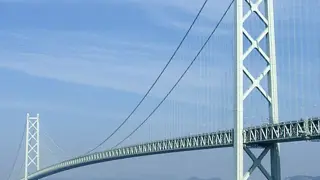
Four decades in the gestation, the bridge is now used by approximately 23,000 cars daily.
A demanding environment
The Akashi Kaikyo Bridge in Japan, also known as the Pearl Bridge, crosses the Akashi Strait to link Kobe with Awaji Island. It's a notoriously difficult stretch of water to navigate: storms and earthquakes stir choppy waves that cause many accidents. A ferry disaster in 1955 convinced the Japanese government to act, demanding safer and easier passage. They demanded a bridge.
Testing the waters
Designers and engineers built complex prototypes to assess their ideas. They placed a 40-metre scale model in a wind tunnel, simulating typhoon conditions to test for aeroelastic flutter. And when it came to construction, they needed to develop a new type of concrete that would mix with seawater to create the 60m-deep foundations.
Colossal construction
Building began in 1988. It took two million workers, 10 years, 181,000 tonnes of steel and 1.4 million cubic metres of concrete to complete. The steel cable used could circle the world seven times. And at 1,991 metres, its central span is the longest of any suspension bridge, anywhere. It was designed with a two-hinged stiffening girder system, meaning it can withstand gusts of up to 177mph. And earthquakes are no longer a disturbance – the bridge can stand tall against tremors up to 8.5 magnitude, thanks to pendulums that dampen any forces acting against it.
